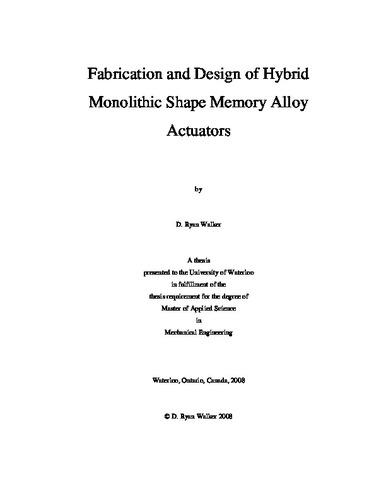| dc.description.abstract | Shape memory alloys (SMA) offer several advantages over traditional electro-mechanical devices,
including: smooth, silent, clean operation; linear actuation; high power/weight ratio; scalability; and reduced part counts. These unique characteristics make them an attractive option when developing actuators, particularly at the meso- and micro-scales. However, SMAs do not typically display cyclic
actuation and, therefore, require some reset force or bias mechanism in order to achieve this behaviour. Additionally, the micro-assembly of SMA material with a reset mechanism becomes increasingly difficult as the dimensions of actuators are scaled down. Therefore, actuators have been developed in which the actuation and reset mechanism are fabricated from a single piece of material.
These actuators are referred to as monolithic actuators.
Monolithic actuators are fabricated from a single piece of SMA material in which local
annealing is used to selectively impart the shape memory effect (SME), while the remainder of the material acts as the bias mechanism. This work proposes an extension to monolithic actuators that locally varies the material composition of the monolithic component to exhibit different mechanical
properties in select regions. This eliminates the need for local annealing by introducing regions of material unaffected by the annealing process. Additionally, incorporating regions of superelastic
material to act as the bias mechanism greatly increases the actuator’s range of motion. These actuators are referred to as hybrid monolithic actuators.
The creation of hybrid monolithic SMA actuators requires the development of both a
fabrication technique and design tool. Varying the composition locally is accomplished by utilizing powder metallurgy fabrication techniques, specifically tape casting. Tapes of different compositions
are cut, stacked, and sintered resulting in a monolithic component with mechanical properties that vary spatially. Tape casting NiTi from elemental powders is studied in this work, and tape recipes and sintering profiles are developed.
In order to model the SMA behaviour of complex geometries, a finite element
implementation of an existing lumped-element SMA model is developed. This model is used to
design and simulate a prototype hybrid monolithic actuator. The prototype is fabricated and its performance used to illustrate the advantages of hybrid design over typical monolithic actuators. | en |

